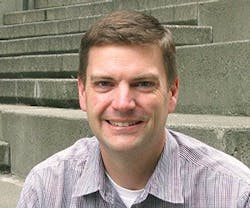BUILDINGS editor Chris Olson talked recently with Brad Pease of Seattle-based green consultant Paladino and Company about factors that undermine the value for building owners in the certification process.
What obstacles and opportunities do building owners overlook when pursuing LEED for existing facilities?
LEED has created a fantastic common language to talk about green certification. It allows an owner to put out a certification RFP and consultants in the marketplace to understand what the owner wants. The owner will probably receive a number of comparable proposals from consultants.
But that ease can be misleading. There are many paths to accumulate points for a certification goal, but the paths have different value for the building owner. LEED is a rating system based on optional points. To get the most out of the process, owners need to collect the points that have the greatest value to them; a blanket RFP may miss those key points if they are not called out.
What factors should an owner consider to find the most value in the process?
Make sure that the RFP includes what you want out of the certification process. Are you also trying to solve an indoor air quality issue? Improve energy performance? Cut expenses? If you have goals other than LEED, be sure that those are clearly identified up front so that consultants have a chance to get into greater depth in their proposal.
For the same reason, an owner shouldn’t necessarily go into the process with a given certification level in mind. That will only encourage a consultant to figure out the quickest and cheapest path to the certification goal, which may not align with your performance goals. That approach can result in spending money on points that don’t add much long-term value.
What should owners do before writing an RFP?
One mistake is to ask on day one, without knowing where your building stands, for the full price to get EBOM certification. We recommend first hiring a consultant to do a gap analysis, which is a simple way to identify the best path to certification. A consultant comes to the building, does a site walkthrough, reviews its ENERGY STAR score and building systems, analyzes water and energy use, and provides an estimate of the current LEED score. The outcome would include an ENERGY STAR score, the services required to meet indoor air quality prerequisites, and operating practices that need to be revamped or updated.
Armed with the gap information, owners can make an informed decision about what they can achieve and then write an RFP for the balance of the work. A gap analysis can be done for about 10% of the consulting cost for the entire certification project. Owners should recoup that cost if they proceed with certification because they will get more out of the remaining 90%.
So the gap analysis should not be based on a particular LEED level?
Correct. It should identify what it would take to reach various certification targets. However, be prepared for some unexpected results. Sometimes the gap analysis reveals that a building has a fundamental issue that makes it unable to meet a LEED prerequisite for energy or ventilation. In such cases, it is easy to redirect efforts toward solving those issues first, which are likely of the highest value to the building and the owners.
Are there other factors that can undermine the owner’s value from the certification process?
Sometimes the LEED-EBOM process creates tension for facility managers. A consultant may propose new ways of running the facility, and the managers may view that situation as a threat.
How can owners avoid such tension between the facility staff and a consultant?
When they evaluate certification consultants, owners should consider if there is a good cultural fit between their organization and the consultants.
You need a consultant who can work with your facility managers, doesn’t point fingers, and effectively collaborates with the team to stay focused on what needs to change. An experienced consultant can clear 90% of the certification hurdles through the application of soft skills rather than through technical brute force.
Brad Pease is a director at Paladino and Company, where he delivers sustainability concepts and technical design strategies to clients. He managed Paladino’s role as technical editor and author of the LEED v4 Reference Guides and currently serves on USGBC’s 2015 LEED Integrative Process Working Group.
